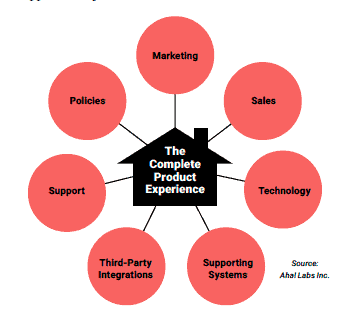Listen to Their Stories, Dig into Their Decisions
Building and marketing a product is a lot like owning a house. Purchasing the home is just the beginning. There will always be lightbulbs to change, grass to mow and taxes to pay. And there will always be strategic improvements that could make your property more appealing to future buyers—from structural things like a new roof to aesthetic fixes like updated hardware.
Likewise, a product’s life cycle requires constant attention and iteration. Your work doesn’t begin and end when customers buy your product. It starts far before that and lasts much longer. For customers to choose your product (and your company) and remain loyal, product managers and product marketers are responsible for the complete product experience (CPE).
I first wrote about this concept in my book Lovability. The core idea behind the CPE is that your product includes every customer touchpoint, even if some of those touchpoints are invisible to them. It encompasses everything from how the product is marketed to interactions with the customer support team, the actual technology, and the internal policies that govern your organization.
The best product teams think about the CPE during every stage of a product’s life cycle. This mindset requires you to consider the pain customers feel before they even start looking for a solution and think about the value they get from your entire organization—not just the product itself—once they choose you. When you’re working in this kind of environment, every decision is evaluated against how it will affect your ability to deliver a CPE.
The two groups most critical to thinking holistically about the customer experience are obvious: product management and product marketing. The product manager is deeply invested in the product life cycle, from setting the strategic vision for what will be built to defining and prioritizing features. The product marketing manager is responsible for communicating the benefits of that product to internal teams and customers, from product training to leading go-to-market efforts. One ensures the product solves a real problem while the other explains why it is better than any other alternative.
So, what is the ideal working relationship between the two roles? How does the CPE fit in? I have seen it firsthand, both earlier in my career and now as co-founder and CEO of Aha!, where we speak with teams daily about product planning, best practices for building roadmaps, and strategies for go-to-market success.
Most companies that get this right do it with a formal product team. This is a cross-functional group that represents the different functional areas you see in “The Complete Product Experience” graphic, excerpted from Lovability. The product manager leads the product team, guiding conversations around the why, when, and what of the product. The product marketing manager has a vital role in guiding the team as well. Together, the two can reorient and rally the organization around an integrated approach to product.
Planning
Goal-first planning ensures that everyone is aligned on delivering a CPE. When everyone in the organization understands what the high-level strategy is, it reduces friction. People can make decisions and evaluate requests more objectively against defined company goals. There is a “true north” for the team, which leads to consistency for customers.
The product manager sets and communicates the strategic vision for the product. Extensive research is conducted before the actual product roadmap can be built—including gathering ideas and input. The product marketing manager uses the product vision to define the go-to-market strategy. This is needed to deliver something new, such as the launch of a product, expansion into a new market or simply introducing enhanced functionality to an existing customer base.
Communication
The product manager leads the product team communication, a cross-functional internal effort. The product marketing manager leads go-to-market and guides ongoing customer communications, coordinating with team members to prepare for the next launch and develop customer-facing marketing activity. There can be a tendency to see this communication as proactive and unidirectional but, really, the product manager and product marketing manager both are product experts and connectors. They are responsible for soliciting and looking for patterns in conversations from teammates who might provide as-yet-untapped opportunities to improve the CPE.
Roadmaps are an important tool in steering those conversations. People understand the greater context for their work when provided with this visual representation of how the product plan will support overall business goals and a timeline for what and when the team delivers. Besides sharing each other’s roadmaps and discussing plans often, product managers and product marketing managers should create a shared calendar or Gantt view to quickly see how changes might affect the overall organization’s ability to sustain the CPE throughout the product life cycle.
Feedback
The product manager focuses on what users want to achieve when using the product. The product marketing manager homes in on what people (both external and internal to the company) need to understand about the product before customers make a purchase and while they’re using it.
The product manager captures feedback from executives, teammates, partners, and customers, then incorporates it into future releases. The product marketing manager may look for insights from prospective customers and current users through educational efforts—for example, product demos to internal teams and presentations to customers. Product marketing managers often are at the front of the effort to capture customer success stories as well. Product management and product marketing should share their learnings with each other so they can continuously improve what is being delivered.
A Strong Foundation Is Key
The importance of a strong product team cannot be stressed enough. Thinking holistically about your product and the entire customer experience is how you create lasting value for your customers and your business. If your organization is not taking this approach, make it a priority to collaborate closely on strategy, plans and timing. Regular meetings and open communication channels between product management and product marketing are key to delivering a winning CPE. Push yourself to move beyond focusing on the technical bits of features and design to cultivate a long-term, mutually beneficial relationship—one in which your customers love every interaction with your product and your company.
Learn More
Certification Courses
Foundations: Uncover the Secrets of Creating a Market-Driven Organization
Author
-

Brian de Haaff, with 30 years of experience, writes and speaks passionately about product and company growth, as well as the pursuit of a meaningful life. Having contributed to companies like Concentric Network, Paglo, and Citrix, he is the co-founder and CEO of Aha! — the world's #1 product development software. For questions or inquiries, please contact [email protected].
View all posts










